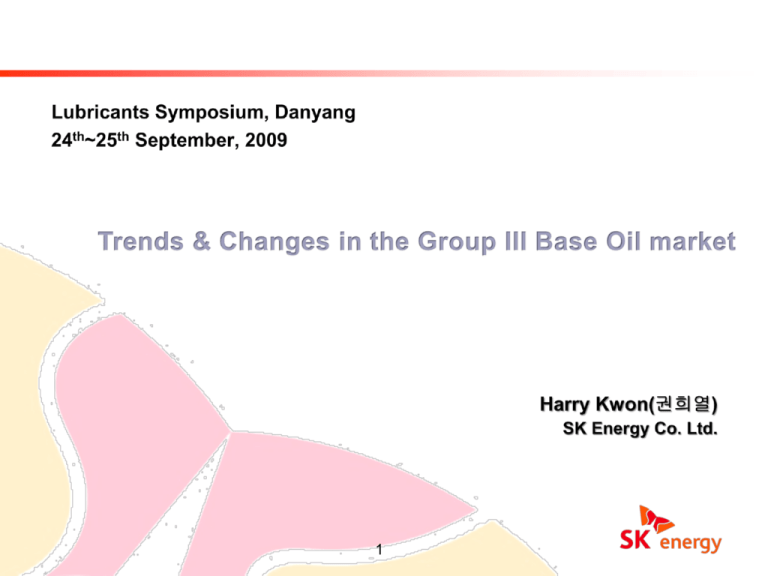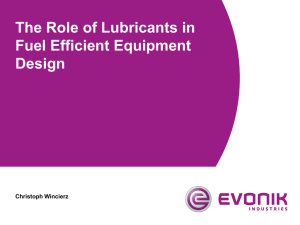Group III
advertisement

1 Presentation Overview SK Energy introduction Group III base oil characteristics Group III base oil supply / demand forecast Market Forces and Demand Drivers for Group III Base Oil Summary 2 SK Group One of the largest enterprises in Korea “Most preferred company to work for” in Korea Energy & Chemicals 86 51% 75 Revenue (US B$) 71 61 50 50 56 SK Group 25 Telecommunications ‘03 ‘04 ‘05 ‘06 ‘07 19% Trading & Services 30% 3 SK Energy • Founded in 1962 as Korea’s first oil refiner • Continues to be the nation’s leading player • Third-largest refining capacity in Asia-Pacific region Refining & Marketing CDU: 1,115,000 B/D RFCC: H/C: 117,000 B/D Upstream Reserves: 500 Mil. Bbl Ethylene: Production: 22,000 B/D Propylene: 840,000 Ton/Yr BTX: 45,000 B/D Lubricant: 4,000 B/D Base Oil: 28,000 B/D Petrochemicals 4 730,000 Ton/Yr 2,607,000 Ton/Yr SK Energy • Two production facilities, Ulsan and Incheon • Operates in more than 20 Countries Domestic Global Employees: 5,661 Gas Stations: 4,519 Storage Terminals: 11 Moscow Almaty London Beijing Houston Tokyo Kuwait Incheon Seoul (HQ) Daejeon Shanghai Guangdong Dubai Singapore Branch Subsidiary Ulsan Exploration LNG Business 5 New Jersey Spin-off Structure According to the BOD resolution on 16th July, Lubricants business of SK Energy split off to a new company “SK Lubricants (tentative name)” Spin-off (‘09.10.1) As-Is 100% subsidiary SK Energy SK Energy SK Lubricants Refining Chemical E&P Lubricants Refining Chemical E&P 윤활유 SK Energy unships Lubricants Biz. Lubricants business exist as one of SK Energy’s biz units in a form of physical division. Newly established company “SK Lubricants” will be launched (100% SK Energy owned subsidiary) 6 Background SK Energy plans to enhance value of the company through separation of competitive individual business units such as lubricants biz. Corporate Governance ‘09 『Best corporate governance』, 『Best audit system』 BOD Focused Management Increasing Competitiveness of each business Create Corporate Value Business Structure Biz structure improvement through spin-off - Active response to environment changes - Acquire appropriate management system for the individual business Developing Growth Options - Responsible management through performance separation - Create value as a lubricants specialized company Enhance flexibility of biz. structure Financial Structure Maintaining Credit Rating Secure liquidity and maintain proper investment level 7 Presentation Overview SK Energy introduction Group III base oil characteristics Group III base oil supply / demand forecast Market Forces and Demand Drivers for Group III Base Oil Summary 8 Base Oil Classification API Base Oil Classification API Category Viscosity Index (VI) Saturates (%) Sulfur (%) Group I 80-120 < 90 and/or >0.03 Group II 80-120 ≥ 90 and ≤ 0.03 Group III 120 + ≥ 90 and ≤ 0.03 GRP II+ GRP III+ Group IV PAO Group V All others 9 Properties of Group III Base Oils 4 cSt Grades Item ASTM Method HC Residue HC Residue Slack Wax (High (1) Waxy) GTL (2) KV @ 100°C, cSt D 445 4.2 4.15 3.9~4.1 3.8~4.2 Viscosity Index(VI) D 2270 122 134 136 135 NOACK Volatility, wt% D 5800 15.2 13.0 <14.8 12.0 D 92 -15 -18 <-18 <-30 D 5293 1590 1130 <1000 <1000 Pour Point, °C CCS Vis @-30°C, cP Source: (1) ExxonMobil website, (2) The 3rd Fuel & Lube Asian Pacific Conference 10 YUBASE Physical Properties Physical properties, YUBASE slate YUBASE 4 YUBASE 4+ YUBASE 6 YUBASE6+ Vis. @40℃, cSt 19.5 18.4 36.9 35.4 Vis. @100℃, cSt 4.22 4.20 6.48 6.65 Viscosity Index 124 134 130 146 Pour Point, ℃ -15 -18 -12 -12 CCS @-25℃, cP - - 2920 2420 CCS @-30℃, cP 1590 1190 5200 4160 Noack (A), wt% 15.2 13.5 7.5 4.1 11 Presentation Overview SK Energy introduction Group III base oil characteristics Group III base oil supply / demand forecast Market Forces and Demand Drivers for Group III Base Oil Summary 12 Group III Production Capacity Most Group III supplier production is located in Asia 38% SK 14% S-Oil 19% Others 3% Petro-Canada 8% Petronas 7% Neste 12% Asia (non-merchant) Source: 2008 Lubes ’N’ Greases 13 60% (3 largest suppliers) Group III Production Capacity How is the capacity of Group III base oil growing and evolving? 14 Base Stock Availability Interdependence Increasing quality requirements Demand shifts to Groups II, III Diminishing production of Group I 2008 Global, bpd Increasing production of Group III stocks 2013 Global, bpd Group III 50,780 Group III 108,170 Group II 199,810 Group II 234,810 Group I 612,450 Source: Lubes N Grease 2008 Group I ?? Announced upcoming capacities. 15 SK Base Oil Production Plan 1~3rd 3rd +4.5 KBD 4th +10 KBD 5th +10 KBD 2n d 1st World largest Group III base oil manufacturer Hydro-cracked / CDW / All hydro processing route Total Group III production capacity is 1.1 million MT/Y Additional new plants will be available in 2012 & 2014 with revamping of current plant(#1~3 plant) 16 Group III Supply/Demand Forecast A : Technical Demand A for Group III (16% annual increase) B : Technical Demand B for Group III (21% annual increase) C : Technical(B) + Commercial Demand for Group III [BPD] C 125,000 B Global Supply Supply by SK energy 100,000 GTL GTL GTL * O : Other Suppliers O GTL 75,000 O O SK 50,000 O SK SK SK SK SK SK SK 2012 2013 2014 O New Plants - SK & Pertamina - PETRONAS/GS O Commerical Demand 25,000 Technical Demand 2003 ....... 2007 2008 2009 17 2010 2011 A Main Issues to be concerned for the future Invisible releasing timing of announced new plants - GTL, New Group III plants....(?) When 0W-20/5W-20 will become the main-grade in the After-Market (Service Fill)? - 2013 after GF-5 ? - Movement toward top tier product The economics of Group I plants Emerging new markets 18 Presentation Overview SK Energy introduction Group III base oil characteristics Group III base oil supply / demand forecast Market Forces and Demand Drivers for Group III Base Oil Summary 19 Market Forces Driving the Use of High Quality Base Oils Legislation Consumers Global Economy Lubricant Manufacturers OEMs 20 OEMs Continue Shift From 10W-30 OEM 0W-20 5W-20 5W-30 Toyota* 2AZ-FE engine: Camry, Solara, Highlander & RAV4 Genuine Oil grade since 2006 1.5 L, 3.5 L Ford Cars and Trucks Main grade Honda Main grade Nissan 2.0 L 2.5 L, 3.5 L Hyundai 2.0 L, 2.4 L, 3.3 L BMW 3.0 L Chevrolet Cars and Trucks 2.2 L, 3.9 L, 4.3 L, 4.8 L GM 2.4 L, 3.8 L, 5.3 L * Source:Toyota TSB EG018-06 21 Grade Shift in US Sales ‘06 MM gals % Change ‘06 vs ‘05 % Change ‘07 vs ‘06 5W-20 65.3 +22 % +11 % 5W-30 231.1 +6 % +5% 10W-30 235.0 -14 % -13 % 10W-40 58.3 -13 % -14 % 20W-50 22.5 -14 % -19 % 5W-40 1.9 +22 % +34 % 10W-30 10.5 +12 % -24 % 15W-40 299.7 0.7 % -0.2 % Top Selling Grades Gasoline Higher Fuel Efficiency Diesel Source: NPRA Sales Report 22 US Gasoline Engine Oil Sales Source: NPRA US Sales Reports Million Gallons 350 10W-30 300 +11 % 250 200 5W-30 -16 % 150 100 50 +20 % 5W-20 0W-20 0 2003 2004 2005 2006 23 2007 2008 Demand Drives the Use of High Quality Base Oils 5W-20 0W-20 •Better Fuel Economy • Durability Base Oil/ Formulation Technology 24 The changes of standard from GF-4 to GF-5 Source: Lubrizol,[www.gf-5.com] 25 ILSAC GF-5 API will announce the new GF-5 specification by the end of 2009, at the earliest; car manufacturers have to use GF-5 for year 2011 vehicle models. Higher fuel economy expectations will increase demand for low viscosity SAE grades: 0W-20, 5W-20. Sequence VID (6D) will be the method used to test for fuel economy Currently developed by a consortium of OEMs, marketers and additive companies. ILSAC GF-5 proposes higher fuel economy specifications than GF-4 limits. The new Sequence VID still to be benchmarked against the existing Sequence VIB test. VID test isn’t ready so comparisons between VIB and VID limits are premature. 26 America’s Outlook for 2010 to 2015 Gasoline Engine Oil - Expect growth of SAE 0W-20 grade for Gasoline Engine Well accepted that SAE 0W-20 will increase fuel economy Honda and Toyota already announced SAE 0W-20 requirements for current (since 2006) and future engines Light Duty Diesel Engine Oil OEMs will want to steer away from SAE 15W-40 oils to gain fuel economy Look for SAE 5W-30 and 5W-40 grades, if not 0W-30 and 0W-40, to maximize fuel economy 27 Key Market Trends – Fuel Economy Group III demand increases with increased fuel economy demands 2011MY CAFE(Corporate Average Fuel Economy) standard may be 27.3mpg, ~8% above current, and 35mpg by 2020 GF-5 will cause 0W-20 and 0W-30 oils to become mainstream OEMs recommend lower viscosity grades for CAFE and fuel economy marketing 100% Group III Group III < 10% 0W-xx 5W-20 5W-30 Select models : 10W-xx Toyota, 15W-xx Honda, 20W-xx Nissan, GM, Monogrades BMW, others 28 Ford main grade Honda main grade Toyota Genuine Oil Hyundai select models Toyota, select models Fuel economy What do these market shifts mean for the Group III Marketers and the Group III base oil markets? 29 Presentation Overview SK Energy introduction Group III base oil characteristics Group III base oil supply / demand forecast Market Forces and Demand Drivers for Group III Base Oil Summary 30 Summary Market forces continue to increase the demand for Group III base stocks SAE 5W-20 and 0W-20 grades will grow and increase demand for Group III base stocks Global Group III new supply from 2011 to 2014 may experience a surplus, depending on announced project schedules Higher VI Group III base stocks enable product differentiation 31







